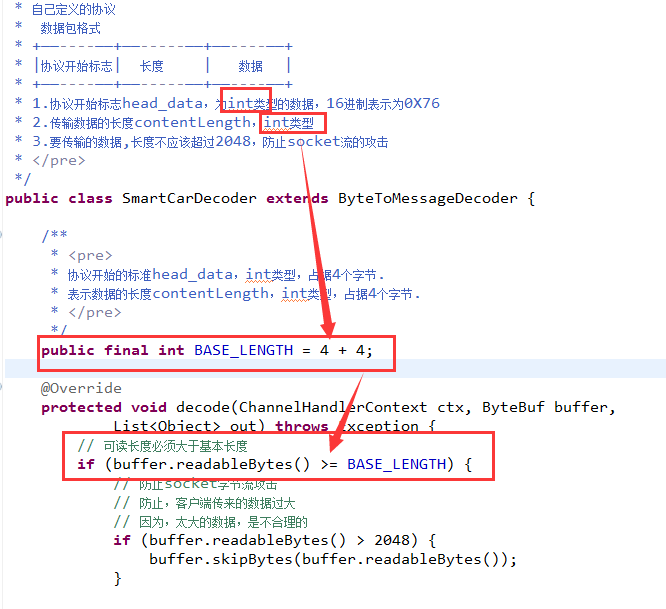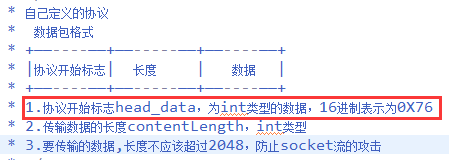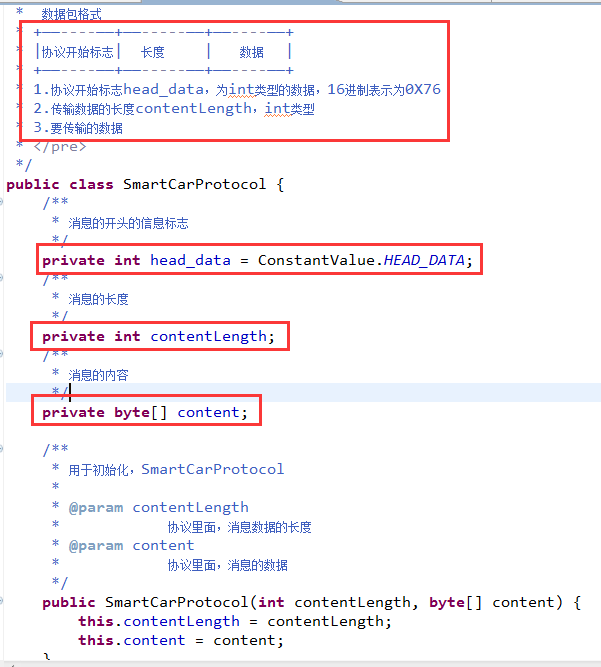1、什么是粘包/拆包
一般所谓的TCP粘包是在一次接收数据不能完全地体现一个完整的消息数据。TCP通讯为何存在粘包呢?主要原因是TCP是以流的方式来处理数据,再加上网络上MTU的往往小于在应用处理的消息数据,所以就会引发一次接收的数据无法满足消息的需要,导致粘包的存在。处理粘包的唯一方法就是制定应用层的数据通讯协议,通过协议来规范现有接收的数据是否满足消息数据的需要。
2、解决办法
2.1、消息定长,报文大小固定长度,不够空格补全,发送和接收方遵循相同的约定,这样即使粘包了通过接收方编程实现获取定长报文也能区分。
2.2、包尾添加特殊分隔符,例如每条报文结束都添加回车换行符(例如FTP协议)或者指定特殊字符作为报文分隔符,接收方通过特殊分隔符切分报文区分。
2.3、将消息分为消息头和消息体,消息头中包含表示信息的总长度(或者消息体长度)的字段
3、自定义协议,来实现TCP的粘包/拆包问题
3.0 自定义协议,开始标记
3.1 自定义协议的介绍
3.2 自定义协议的类的封装
3.3 自定义协议的编码器
3.4 自定义协议的解码器

4、协议相关的实现
4.1 协议的封装
import java.util.Arrays;
/**
* <pre>
* 自己定义的协议
* 数据包格式
* +——----——+——-----——+——----——+
* |协议开始标志| 长度 | 数据 |
* +——----——+——-----——+——----——+
* 1.协议开始标志head_data,为int类型的数据,16进制表示为0X76
* 2.传输数据的长度contentLength,int类型
* 3.要传输的数据
* </pre>
*/
public class SmartCarProtocol {
/**
* 消息的开头的信息标志
*/
private int head_data = ConstantValue.HEAD_DATA;
/**
* 消息的长度
*/
private int contentLength;
/**
* 消息的内容
*/
private byte[] content;
/**
* 用于初始化,SmartCarProtocol
*
* @param contentLength
* 协议里面,消息数据的长度
* @param content
* 协议里面,消息的数据
*/
public SmartCarProtocol(int contentLength, byte[] content) {
this.contentLength = contentLength;
this.content = content;
}
public int getHead_data() {
return head_data;
}
public int getContentLength() {
return contentLength;
}
public void setContentLength(int contentLength) {
this.contentLength = contentLength;
}
public byte[] getContent() {
return content;
}
public void setContent(byte[] content) {
this.content = content;
}
@Override
public String toString() {
return "SmartCarProtocol [head_data=" + head_data + ", contentLength="
+ contentLength + ", content=" + Arrays.toString(content) + "]";
}
}4.2 协议的编码器
/**
* <pre>
* 自己定义的协议
* 数据包格式
* +——----——+——-----——+——----——+
* |协议开始标志| 长度 | 数据 |
* +——----——+——-----——+——----——+
* 1.协议开始标志head_data,为int类型的数据,16进制表示为0X76
* 2.传输数据的长度contentLength,int类型
* 3.要传输的数据
* </pre>
*/
public class SmartCarEncoder extends MessageToByteEncoder<SmartCarProtocol> {
@Override
protected void encode(ChannelHandlerContext tcx, SmartCarProtocol msg,
ByteBuf out) throws Exception {
// 写入消息SmartCar的具体内容
// 1.写入消息的开头的信息标志(int类型)
out.writeInt(msg.getHead_data());
// 2.写入消息的长度(int 类型)
out.writeInt(msg.getContentLength());
// 3.写入消息的内容(byte[]类型)
out.writeBytes(msg.getContent());
}
}4.3 协议的解码器
import java.util.List;
import io.netty.buffer.ByteBuf;
import io.netty.channel.ChannelHandlerContext;
import io.netty.handler.codec.ByteToMessageDecoder;
/**
* <pre>
* 自己定义的协议
* 数据包格式
* +——----——+——-----——+——----——+
* |协议开始标志| 长度 | 数据 |
* +——----——+——-----——+——----——+
* 1.协议开始标志head_data,为int类型的数据,16进制表示为0X76
* 2.传输数据的长度contentLength,int类型
* 3.要传输的数据,长度不应该超过2048,防止socket流的攻击
* </pre>
*/
public class SmartCarDecoder extends ByteToMessageDecoder {
/**
* <pre>
* 协议开始的标准head_data,int类型,占据4个字节.
* 表示数据的长度contentLength,int类型,占据4个字节.
* </pre>
*/
public final int BASE_LENGTH = 4 + 4;
@Override
protected void decode(ChannelHandlerContext ctx, ByteBuf buffer,
List<Object> out) throws Exception {
// 可读长度必须大于基本长度
if (buffer.readableBytes() >= BASE_LENGTH) {
// 防止socket字节流攻击
// 防止,客户端传来的数据过大
// 因为,太大的数据,是不合理的
if (buffer.readableBytes() > 2048) {
buffer.skipBytes(buffer.readableBytes());
}
// 记录包头开始的index
int beginReader;
while (true) {
// 获取包头开始的index
beginReader = buffer.readerIndex();
// 标记包头开始的index
buffer.markReaderIndex();
// 读到了协议的开始标志,结束while循环
if (buffer.readInt() == ConstantValue.HEAD_DATA) {
break;
}
// 未读到包头,略过一个字节
// 每次略过,一个字节,去读取,包头信息的开始标记
buffer.resetReaderIndex();
buffer.readByte();
// 当略过,一个字节之后,
// 数据包的长度,又变得不满足
// 此时,应该结束。等待后面的数据到达
if (buffer.readableBytes() < BASE_LENGTH) {
return;
}
}
// 消息的长度
int length = buffer.readInt();
// 判断请求数据包数据是否到齐
if (buffer.readableBytes() < length) {
// 还原读指针
buffer.readerIndex(beginReader);
return;
}
// 读取data数据
byte[] data = new byte[length];
buffer.readBytes(data);
SmartCarProtocol protocol = new SmartCarProtocol(data.length, data);
out.add(protocol);
}
}
}4.4 服务端加入协议的编/解码器

4.5 客户端加入协议的编/解码器
5、服务端的实现
import io.netty.bootstrap.ServerBootstrap;
import io.netty.channel.ChannelFuture;
import io.netty.channel.ChannelInitializer;
import io.netty.channel.ChannelOption;
import io.netty.channel.EventLoopGroup;
import io.netty.channel.nio.NioEventLoopGroup;
import io.netty.channel.socket.SocketChannel;
import io.netty.channel.socket.nio.NioServerSocketChannel;
import io.netty.handler.logging.LogLevel;
import io.netty.handler.logging.LoggingHandler;
public class Server {
public Server() {
}
public void bind(int port) throws Exception {
// 配置NIO线程组
EventLoopGroup bossGroup = new NioEventLoopGroup();
EventLoopGroup workerGroup = new NioEventLoopGroup();
try {
// 服务器辅助启动类配置
ServerBootstrap b = new ServerBootstrap();
b.group(bossGroup, workerGroup)
.channel(NioServerSocketChannel.class)
.handler(new LoggingHandler(LogLevel.INFO))
.childHandler(new ChildChannelHandler())//
.option(ChannelOption.SO_BACKLOG, 1024) // 设置tcp缓冲区 // (5)
.childOption(ChannelOption.SO_KEEPALIVE, true); // (6)
// 绑定端口 同步等待绑定成功
ChannelFuture f = b.bind(port).sync(); // (7)
// 等到服务端监听端口关闭
f.channel().closeFuture().sync();
} finally {
// 优雅释放线程资源
workerGroup.shutdownGracefully();
bossGroup.shutdownGracefully();
}
}
/**
* 网络事件处理器
*/
private class ChildChannelHandler extends ChannelInitializer<SocketChannel> {
@Override
protected void initChannel(SocketChannel ch) throws Exception {
// 添加自定义协议的编解码工具
ch.pipeline().addLast(new SmartCarEncoder());
ch.pipeline().addLast(new SmartCarDecoder());
// 处理网络IO
ch.pipeline().addLast(new ServerHandler());
}
}
public static void main(String[] args) throws Exception {
new Server().bind(9999);
}
}
import io.netty.channel.ChannelHandlerAdapter;
import io.netty.channel.ChannelHandlerContext;
public class ServerHandler extends ChannelHandlerAdapter {
// 用于获取客户端发送的信息
@Override
public void channelRead(ChannelHandlerContext ctx, Object msg)
throws Exception {
// 用于获取客户端发来的数据信息
SmartCarProtocol body = (SmartCarProtocol) msg;
System.out.println("Server接受的客户端的信息 :" + body.toString());
// 会写数据给客户端
String str = "Hi I am Server ...";
SmartCarProtocol response = new SmartCarProtocol(str.getBytes().length,
str.getBytes());
// 当服务端完成写操作后,关闭与客户端的连接
ctx.writeAndFlush(response);
// .addListener(ChannelFutureListener.CLOSE);
// 当有写操作时,不需要手动释放msg的引用
// 当只有读操作时,才需要手动释放msg的引用
}
@Override
public void exceptionCaught(ChannelHandlerContext ctx, Throwable cause)
throws Exception {
// cause.printStackTrace();
ctx.close();
}
}
import io.netty.bootstrap.Bootstrap;
import io.netty.channel.ChannelFuture;
import io.netty.channel.ChannelInitializer;
import io.netty.channel.ChannelOption;
import io.netty.channel.EventLoopGroup;
import io.netty.channel.nio.NioEventLoopGroup;
import io.netty.channel.socket.SocketChannel;
import io.netty.channel.socket.nio.NioSocketChannel;
public class Client {
/**
* 连接服务器
*
* @param port
* @param host
* @throws Exception
*/
public void connect(int port, String host) throws Exception {
// 配置客户端NIO线程组
EventLoopGroup group = new NioEventLoopGroup();
try {
// 客户端辅助启动类 对客户端配置
Bootstrap b = new Bootstrap();
b.group(group)//
.channel(NioSocketChannel.class)//
.option(ChannelOption.TCP_NODELAY, true)//
.handler(new MyChannelHandler());//
// 异步链接服务器 同步等待链接成功
ChannelFuture f = b.connect(host, port).sync();
// 等待链接关闭
f.channel().closeFuture().sync();
} finally {
group.shutdownGracefully();
System.out.println("客户端优雅的释放了线程资源...");
}
}
/**
* 网络事件处理器
*/
private class MyChannelHandler extends ChannelInitializer<SocketChannel> {
@Override
protected void initChannel(SocketChannel ch) throws Exception {
// 添加自定义协议的编解码工具
ch.pipeline().addLast(new SmartCarEncoder());
ch.pipeline().addLast(new SmartCarDecoder());
// 处理网络IO
ch.pipeline().addLast(new ClientHandler());
}
}
public static void main(String[] args) throws Exception {
new Client().connect(9999, "127.0.0.1");
}
}
import io.netty.channel.ChannelHandlerAdapter;
import io.netty.channel.ChannelHandlerContext;
import io.netty.util.ReferenceCountUtil;
//用于读取客户端发来的信息
public class ClientHandler extends ChannelHandlerAdapter {
// 客户端与服务端,连接成功的售后
@Override
public void channelActive(ChannelHandlerContext ctx) throws Exception {
// 发送SmartCar协议的消息
// 要发送的信息
String data = "I am client ...";
// 获得要发送信息的字节数组
byte[] content = data.getBytes();
// 要发送信息的长度
int contentLength = content.length;
SmartCarProtocol protocol = new SmartCarProtocol(contentLength, content);
ctx.writeAndFlush(protocol);
}
// 只是读数据,没有写数据的话
// 需要自己手动的释放的消息
@Override
public void channelRead(ChannelHandlerContext ctx, Object msg)
throws Exception {
try {
// 用于获取客户端发来的数据信息
SmartCarProtocol body = (SmartCarProtocol) msg;
System.out.println("Client接受的客户端的信息 :" + body.toString());
} finally {
ReferenceCountUtil.release(msg);
}
}
@Override
public void exceptionCaught(ChannelHandlerContext ctx, Throwable cause)
throws Exception {
ctx.close();
}
}
http://www.cnblogs.com/whthomas/p/netty-custom-protocol.html
http://www.cnblogs.com/fanguangdexiaoyuer/p/6131042.html








 本文详细解析了TCP通讯中粘包现象的原因及其解决方案,并提供了自定义协议的具体实现,包括协议的设计思路、编码器与解码器的编写等。
本文详细解析了TCP通讯中粘包现象的原因及其解决方案,并提供了自定义协议的具体实现,包括协议的设计思路、编码器与解码器的编写等。





















 877
877

 被折叠的 条评论
为什么被折叠?
被折叠的 条评论
为什么被折叠?








